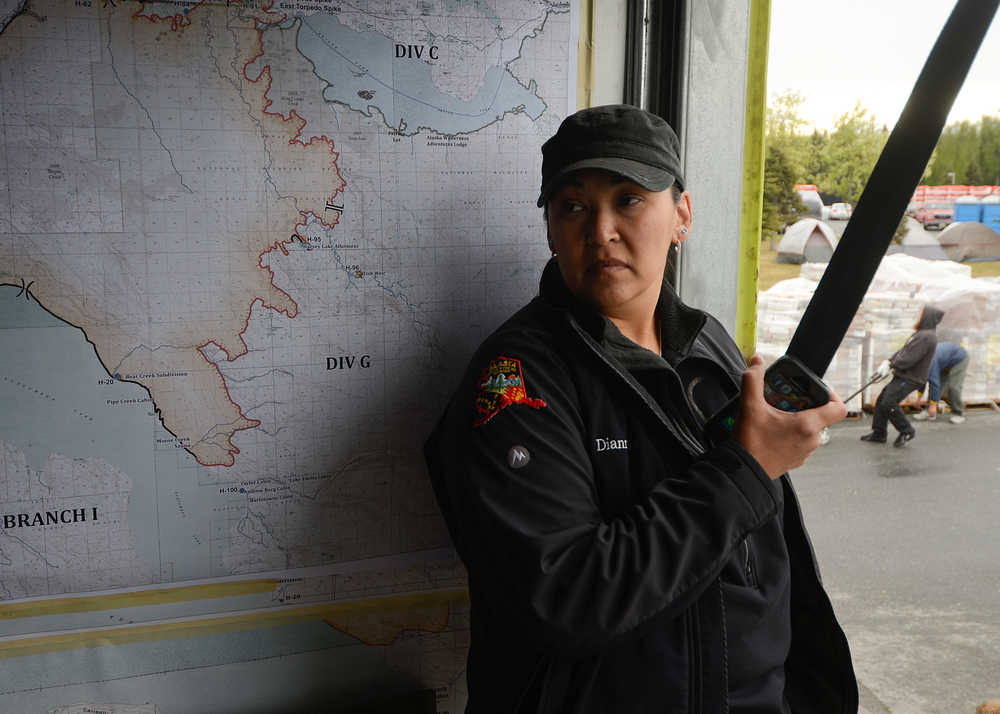On a cool, wet morning at a temporary open-air warehouse in Soldotna, Tom Vangs directs warehouseman Scott Johnson as the two stack firehose onto a pallet to be wrapped and shipped back to a firefighting supply warehouse in Alaska.
Vangs, a cache demobilization specialist from Ontario, Oregon, is one of several people who run the supply chain that supports firefighter efforts to control the Funny River Horse Trail wildfire — a burn that has consumed more than 193,000 acres of Kenai National wildlife refuge land and threatened several communities along the Sterling Highway and Funny River Road.
Now, as the wet weather continues, warehouse workers are receiving nearly as many supplies as they send out each day and efforts to demobilize the hastily set-up supply warehouse run alongside continued daily orders from firefighters still working to strengthen fire lines and ensure that the wildfire is under control.
Each day, the Alaska Interagency Incident Management Team tasked with managing the fire releases an updated map of the spread and areas of control for the wildfire. Red lines around the parameter of the fire indicate areas that are uncontrolled burns, groupings of crosshatched black lines indicate areas where bulldozers have been used to construct fire lines and the thick black lines that have slowly overtaken the perimeter maps released in the last week of May — show areas where firefighters have completed fire lines, halting the spread of the massive wildfire.
While residents who see the map can use it to track the progression of fire containment and gauge their proximity to the burned areas, Dianna Prior, a receiving and distribution manager in the temporary warehouse, can read the map and know which supplies she’ll be sending out and which she’ll be getting back.
“At the beginning, it’s a lot of hose, pumps, chainsaws. When structures are involved, then we know that it’s a lot of hose and sprinkler kits. A lot of pumps will go out usually when they’re trying to draw water to save houses,” Prior said. “Then, when (the map) starts getting more black — we know we’re going to start getting a lot of stuff back. People will be demob(ilizing) and we’ll be checking in crews as they come back.”
Prior, who has worked as a receiving and distribution manager for 12 years stood in the doorway of a 40-foot trailer designed as a type of kit for management of a fire classified as a Type II incident. The neon green trailer has sat open in the Skyview High School parking lot for nearly 10 days as supply managers arrive on scene to coordinate delivery of everything from food, to clean clothes, to office supplies for the more than 700 personnel now working the fire.
“It gets chaotic,” Prior said.
As firefighting effort and personnel increase, so does demand on the warehouse. Before the caterer arrived to offer regular meal-times the warehouse distributes field rations and fresh food boxes to firefighting crews.
“The store may not be stocked initially but we try to get out as much as we can to get (firefighters) as prepared as they can be and so the first few days are always kind of a rush to try and get things here that we know they’re going to need,” said Daniel Tanner, warehouse manager. “After four or five days here, in this case, we’re really kind of more comfortable and have the supplies here that they’ll need.”
Sometimes, that equipment has been in use for so long — it’s easy to anticipate that it will be needed.
Tanner lifted the handle of a World War II-era canvas and wooden-frame packboard used for carrying gear out into the woods. The black-ink stamped board dated to 1944.
“In a lot of cases, the equipment for a wildfire hasn’t really changed in a long time,” Tanner said. “Sometimes you can’t really improve on a good system.”
Staff work 120 hours a week to support the firefighting efforts and it can be exhausting, but someone needs to be on hand to fill orders from firefighters who need to be able to respond to the changing behavior of a wildfire, Prior said.
“When you’re on a fire, you know you’re going to work really hard,” she said.
Tanner said that as activity on the fire dies down — operation ramps up in the warehouse as workers prepare pallets of firefighting equipment to be returned to warehouses around the state where gear can be cleaned and stored until the next fire crew calls to order it.
“It’s a matter of finding the balance of keeping enough here on hand to be able to supply the guys with what they need as the fire is kind of closing out, as well as making sure that we can send as much back as we can so we don’t end up with a huge pile of equipment to send back all at once because that’s very difficult to do logistically,” he said.
Evidence that the fire is increasingly under control can be seen in the huge stack of dirty fire hose accumulating at the warehouse.
Tanner, who typically works at a fire supply warehouse in Fairbanks, said it’s difficult to keep track of how much equipment flows through the warehouse —even in the short time that the Funny River wildfire has been burning.
“Past 100 pallets, you just kind of lose track,” he said.
Reach Rashah McChesney at rashah.mcchesney@peninsulaclarion.com

